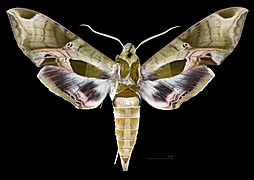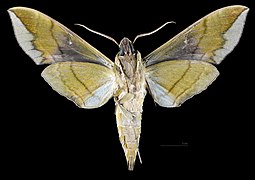Eumorpha pandorus
| Eumorpha pandorus | ||||||||||||
|---|---|---|---|---|---|---|---|---|---|---|---|---|

Eumorpha pandorus |
||||||||||||
| Systematics | ||||||||||||
|
||||||||||||
| Scientific name | ||||||||||||
| Eumorpha pandorus | ||||||||||||
| ( Huebner , 1821) |
Eumorpha pandorus is a butterfly ( moth ) from the swarm family (Sphingidae).
features
The moths reach a wingspan of 82 to 115 millimeters, with the females being larger than the males. Your forewing outer edge is slightly serrated. The color of the top of the forewing varies from olive brown to greenish tones. At the apex and at the inner edge is dark green lift to dark brown areas. The discoid spot of the same color is small and divided. The middle of the front edge shows a pink field. The upper side of the hind wing corresponds in color to the forewings, is somewhat darkened and shows a pink field at the anal angle . The thorax is thinly haired in the color of the fore wings. A dark green to dark brown area in the shape of a triangle can be seen on each side. The abdomen has a similar color to the thorax.
Caterpillar
The caterpillars appear in very different color variants. This is how brown, red, or green individuals appear. The white round spots on the sides of the middle segments are striking. At the end of the body there is a short anal horn .
Similar species
- In the oleander swarm ( Daphnis nerii ) the greenish color elements predominate on the wings. There is a dark eye-spot on either side of the forewing root. The species occurs in Europe, Africa and Asia, so there is no geographical overlap with Eumorpha pandorus .
- Daraspa myron is much smaller with a wingspan of 45 to 65 millimeters and is distinguished by the orange rear wings.
Distribution and occurrence
The species is widespread in the east, southeast and central North America from Nova Scotia and Ontario in a southerly direction to Florida and Texas . It prefers to live on rocky slopes and in vineyards.
Way of life
The crepuscular and nocturnal moths fly in one or two generations between April and October, depending on where they are found. They suck nectar from the flowers of petunias ( Petunia ), soap herbs ( Saponaria ) and Pechnelken ( Lychnis ) and visit artificial light sources . The caterpillars feed on the leaves of various plants, including grapevines - ( Vitis ), Ampelopsis - and virgin vines ( Parthenocissus ).
Individual evidence
Web links
- bugguide - Photos at Bug Guide
- itis report - taxonomy




